Change your mindset, not your methodology
When delivery goes pear-shaped the project methodology is often blamed.

Many articles are written about the pros and cons of Agile vs Waterfall project delivery methodologies and different Enterprise Delivery Frameworks.
Countless hours are spent debating which one to choose and then more hours training project staff and familiarising business stakeholders with terminology and process. Often, one methodology can be seen as a panacea, whilst another approach is demonised.
When delivery goes pear-shaped, budgets blow out, timeframes shift to the right, scope gets deferred and stakeholder expectations aren’t met, the project methodology is often blamed.
WHAT IF WE TOLD YOU MINDSET, NOT METHODOLOGY, IS THE CAUSE?
A lack of trust, a culture of blame, absence of transparency and a denial of access to timely, relevant information can kill delivery. We’ve all seen examples, a lack of accountability and unclear responsibilities, employees unempowered to make decisions out of fear of failure and the hoarding of information by a select few.
There are 8 principles born from DSDM Agile, but not exclusive to Agile, which underpins what good looks like in all project delivery, regardless of methodology. They orient teams and organisations towards a performance mindset by promoting openness and transparency, trust, accountability, and solution orientation.
- Focus on the business need
- Deliver on time
- Collaborate—it builds shared ownership
- Never compromise quality
- Build incrementally from firm foundations
- Deliver iteratively (yes, even with waterfall)
- Communicate continuously and clearly
- Demonstrate control by tracking and reporting progress.
It takes courage to admit that a shift in mindset, not project methodology, might bring greater success. Mindset influences culture, changes practices, procedures and habits and permeates messages. It’s a powerful enabler.
These 8 principles are more likely to improve delivery performance and the realisation of benefits than any extended debate over the choice of methodology.
Want to speak to a trusted expert on the best approach to your next project? Contact us today.
Share this content





